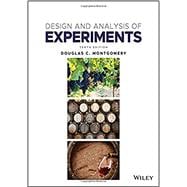Design and Analysis of Experiments provides a rigorous introduction to product and process design improvement through quality and performance optimization. Clear demonstration of widely practiced techniques and procedures allows readers to master fundamental concepts, develop design and analysis skills, and use experimental models and results in real-world applications. Detailed coverage of factorial and fractional factorial design, response surface techniques, regression analysis, biochemistry and biotechnology, single factor experiments, and other critical topics offer highly-relevant guidance through the complexities of the field.
Stressing the importance of both conceptual knowledge and practical skills, this text adopts a balanced approach to theory and application. Extensive discussion of modern software tools integrate data from real-world studies, while examples illustrate the efficacy of designed experiments across industry lines, from service and transactional organizations to heavy industry and biotechnology. Broad in scope yet deep in detail, this text is both an essential student resource and an invaluable reference for professionals in engineering, science, manufacturing, statistics, and business management.









